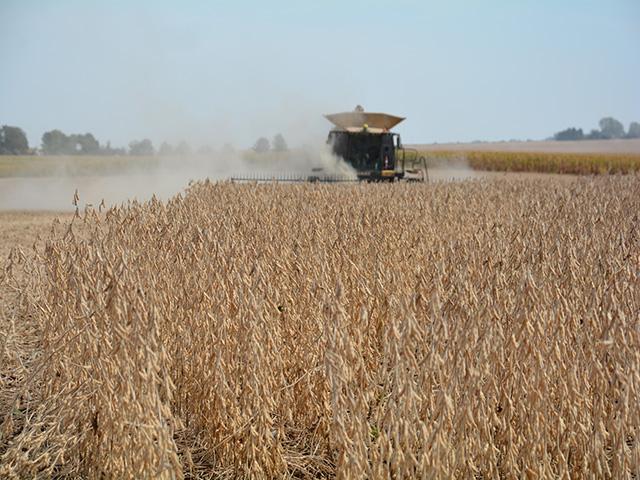FAS in China on Trade and Soybeans
China Soybean Users See Breakthrough for US Imports, FAS Beijing Staff Says
(DTN) -- China may import U.S. soybeans in the first half of this marketing year, but end-users prepare for other options, considering the trade tariff dispute between the two countries, the Foreign Agricultural Service staff in Beijing reported on Monday.
"Industry contacts believe that the U.S. and China are likely to come to some sort of agreement to allow some volumes of U.S. soybeans to enter the Chinese market in the first half of the 2025/2026 marketing year, but are preparing for alternative scenarios," the attache stated in the FAS report.
According to USDA FAS Export Sales data, China has not made purchases of soybeans from the U.S. since May 2025 and, as of Sept. 11, had not made any purchases of new-crop soybeans.
Currently, U.S. soybeans face a 23% tariff entering China, making them uncompetitive in the commercial market, the FAS attache report said.
In its Oilseeds and Products Update Report, the attache stated the U.S. Post (embassy) maintains its soybean China import forecast at 106 million metric tons (mmt) for 2025-26.
This contrasts USDA's official estimate that China would import 112 mmt of soybeans for the 2025-26 marketing year.
The forecasts, issued by FAS China, are not official USDA data.
The relatively stable forecast for soybean imports is linked to restrained growth in crushing demand at 2% and continued efforts by Beijing to limit import growth, the Post report stated.
P[L1] D[0x0] M[300x250] OOP[F] ADUNIT[] T[]
Beijing is expected to continue to pressure crushers (especially state-owned enterprises) to utilize more domestic soybeans, despite their uncompetitive price and the logistical difficulty in transporting them from northeast China to demand centers further south, the attache noted.
Approximately 3.0 mmt of domestic soybeans, more than food use, are forecast to be available. China may also begin auctioning soybeans from state reserves at a faster pace than is typically necessary to "turn over" old stocks, the attache report said.
The Beijing-based Post reported that available data indicate state reserve soybean auctions have been limited so far this year, and buy-up of available supplies has been well below the volumes offered.
PRODUCTION
Post raises its forecast for marketing year 2025-26 soybean production slightly to 19.9 mmt on generally favorable weather conditions in northern China and slightly higher planted area.
CONSUMPTION
Post reduces its forecast for total oilseeds for crushing in marketing year 2025-26 to 139.1 mmt from the 140.7 mmt in the previous report on lower rapeseed crushing.
Post maintains its forecasts for China's soybean crushing for marketing year 2025-26 at 101 mmt. Lower soybean meal prices continue to incentivize the feed sector's usage of it, which will continue driving soybean crushing in the second half of 2025. The Chinese market remains non-transparent, and publicly available sources face pressure to align with official narratives.
China is seeking to reduce its dependency on imported soybeans, and China's Ministry of Agriculture and Rural Affairs (MARA) has been tasked to find ways to reduce demand for soybean meal, the attache reported.
China's Ministry of Agriculture and Rural Affairs (MARA) set a goal of reducing the soybean meal inclusion rate in feed by 0.5% a year from 14.5% in 2023 to 13.0% in 2025, which would have reduced soybean meal use by 8.7 mmt. Post expects that low soybean meal prices will continue to drive soybean meal use in feed production in marketing year 2025-26 and beyond.
DEMAND FOR FOOD USE SOYBEANS
Post forecasts China's soybeans for food use for marketing year 2025-26 at 17 mmt, down 0.5 mmt from the estimate for 2024-25, based largely on declining prices for meat products that compete with soy-based products.
China's population continues to age and decline, while also continuing to urbanize, setting up countervailing consumption patterns that require more study.
CANADIAN CANOLA
Post also forecasts lower imports of rapeseed due to China's trade frictions with Canada. The largest supplier of rapeseed for two decades -- primarily canola -- Canada now faces a 75.8% anti-dumping tariff, though the final determination of that dumping case has now been pushed back until next March. Still, the temporary duty remains in place, "effectively cutting off future imports of Canadian canola."
China also now is looking to restart some rapeseed imports from Australia as a result.
The full report can be found at https://gain.fas.usda.gov/…
DTN Ag Policy Editor Chris Clayton contributed to this report.
Mike McGinnis can be reached at mcginnis100@gmail.com
(c) Copyright 2025 DTN, LLC. All rights reserved.




